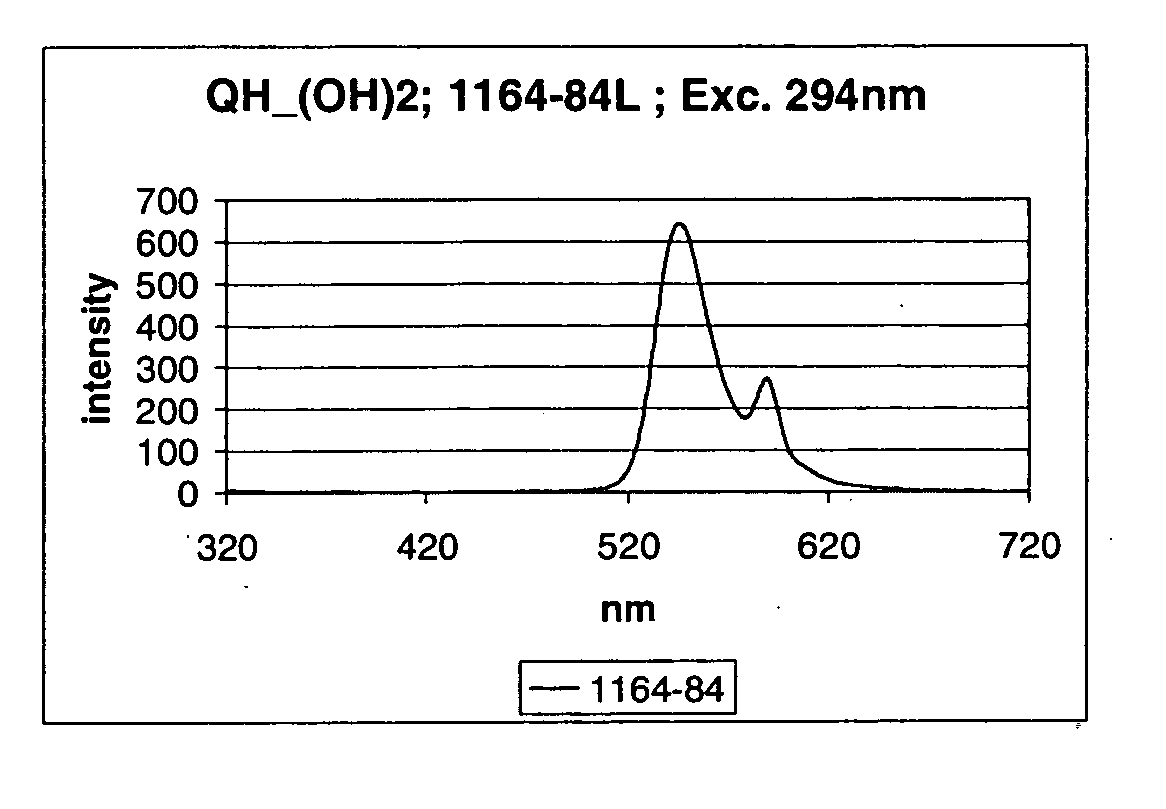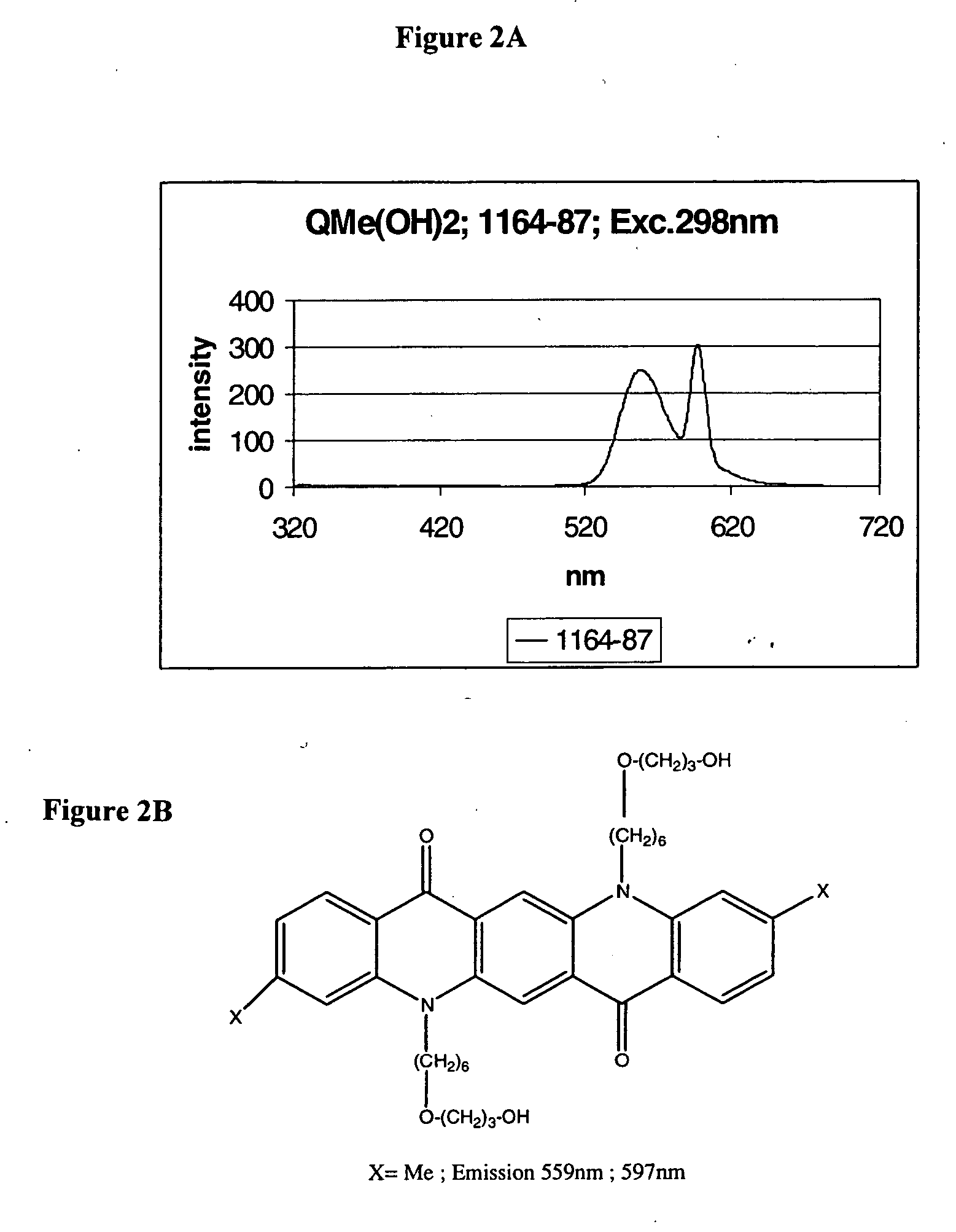Flourecent quinacridone derivatives
a technology of quinacridone and quinacridone, which is applied in the field of flourecent quinacridone derivatives, can solve the problems of general safety problems, need for specially trained personnel, and many basic difficulties in the use of radioisotopes, and achieve the effect of increasing the solubility of quinacridon
- Summary
- Abstract
- Description
- Claims
- Application Information
AI Technical Summary
Benefits of technology
Problems solved by technology
Method used
Image
Examples
example 1
Derivatization of Magenta and Magenta B Quinacridones
[0106] This example describes the derivatization of quinacridones (Magenta and Magenta B) with Br—(CH2)3—O-DMT using the synthesis procedure described in U.S. Pat. No. 5,725,651. The derivatization was performed to convert the starting material into the fluorescent derivative and to increase the solubility of the starting quinacridone. The results of this experiment indicated that the described method is not suitable for the derivatization of quinacridones with Br—(CH2)3—O-DMT.
[0107] The derivatization is an alkylation reaction performed in organic solvents such as tetrahyrofuran, N,N-dimethylformamide, dioxane, DMSO, N,N-dimethylacetamide or N-methylpyrrolidone and in the presence of sodium hydride as a strong base:
[0108] The alkylation of the 2,9-chloroquinacridone and 2,9-dimethylquinacridone (Magenta B and Magenta respectively) using DMT protected 3-Bromo propanol-1 was performed according to the protocol described in the ...
example 2
Derivatization of Magenta and Magenta B Quinacridones
[0113] In this Example, an alternate synthetic protocol was applied. This protocol utilizes Phase Transfer Catalysis in which a heterogeneous mixture of a saturated solution of sodium hydroxide and the inert organic solvent is used as a reaction medium. This method avoids the use of sodium hydride, which represents a dangerous material. In a number of small-scale experiments a new efficient protocol for the derivatization of quinacridones was developed.
[0114] Alkylation experiments were performed using commercially available 1,6-dibromohexane.
A. Synthesis of the dibromo-derivative of 2,9-dichloroquinacridone
[0115] 1 g (0.006247 mol) of 2,9-chloroquinacridone (Magenta B, F.W. 381) was suspended in 50 ml of saturated NaOH / Water: 50 ml toluene and magnetically stirred. 1.125 g (0.00305 mol) of tetrabutyl ammonium iodide was added and subsequently the resulting mixture was stirred at 50° C. for 15 min and at room temp for 50 min...
example 3
DMT protection of the bis-hydroxyl derivative of 2,9-dichloroquinacridone
[0125]
[0126] This example describes the DMT protection of the bis-hydroxyl derivative of 2,9-dichloroquinacridone in order to facilitate the attachment of the quinacridone to a phosphoramidite. 0.5344 g (0.0007667 mol) of the bis-hydroxyl derivative synthesized in Example 2B (F.W. 697) was dissolved in a solution of 4 ml of dry chloroform (Aldrich) and 0.5 ml (0.371 g, 0.00287 mol) of ethyl triisopropylamine (Aldrich). Subsequently, 0.1 g (0.0002951 mol) of dimethoxytrityl chloride (Aldrich) was added and the resulting reaction mixture was stirred overnight under dry nitrogen.
[0127] TLC analysis (Merck silica plates, mobil phase—dichloromethane / 10% Methanol) indicated the formation of new material; Rf=0.6. After concentration under reduced pressure, the residue was re-dissolved in a minimal volume of dichloromethane / 10% methanol and applied to a silica column (70-230 mesh / dichloromethane / 10% methanol). Produc...
PUM
| Property | Measurement | Unit |
|---|---|---|
| Fraction | aaaaa | aaaaa |
| Fraction | aaaaa | aaaaa |
| Fraction | aaaaa | aaaaa |
Abstract
Description
Claims
Application Information
 Login to View More
Login to View More - R&D
- Intellectual Property
- Life Sciences
- Materials
- Tech Scout
- Unparalleled Data Quality
- Higher Quality Content
- 60% Fewer Hallucinations
Browse by: Latest US Patents, China's latest patents, Technical Efficacy Thesaurus, Application Domain, Technology Topic, Popular Technical Reports.
© 2025 PatSnap. All rights reserved.Legal|Privacy policy|Modern Slavery Act Transparency Statement|Sitemap|About US| Contact US: help@patsnap.com



